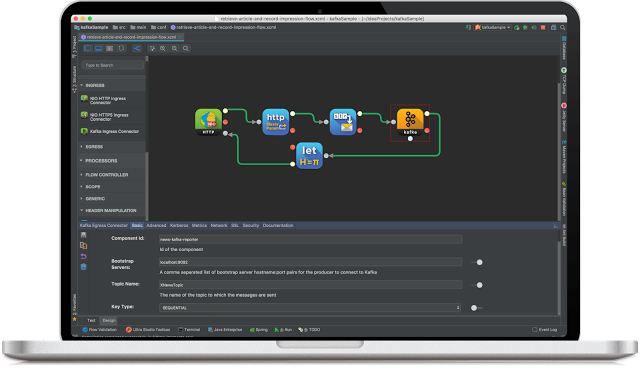Digital Transformation through Composable Integration
Digitalization is heavily used in enterprises today to achieve business success. Business entities which do not embrace this change are losing their market share and going down day-by-day, as the human society is now experiencing digitalization at a global scale. This experience starts with all day-to-day activities to the major political, industrial, informational, educational and even cultural engagements. In essence, we are experiencing a Digital Revolution.

There are many examples of businesses not being able to transform itself with the emerging technologies and be defeated by their competitors:
- Kodak defeated by the Digital Camera, mainly by Nikon and Canon
- Nokia defeated by the smartphones, mainly by Samsung and Apple
- BlockBuster Video defeated by online streaming, mainly by Netflix
- Borders Books and Music defeated by online Bookstores, mainly by Amazon
And this list continues..
Digital Transformation
With digitalization, consumer expectations on the quality of a service and the speed or the turnover time of the service have increased dramatically. Lack of adherence to this change is usually seen by the consumer market as lack of innovation in products and services. The process of shifting from the existing business methodologies to the new digitalized business methodologies or offerings is considered as Digital Transformation. A more formalized definition to this could be given as;
“Digital Transformation is the use of technology to radically improve performance or reach of the enterprise”
Let me take an example from the FIT (Fully Independent Traveller) domain. Assume that there is a good hotel booking service, available probably over the internet and many other media (such as via a call-center, a physical office, etc.) and they have had a very good market share of the hotel bookings. However if they continue to provide the same service that they have used to be offering, they will sure be losing their market share as there are competing services emerging to provide better QoS, lower response times and possibly novel and more convenient media (such as mobile applications); and most importantly, a better experience for the bookings through the use of new technology.

So how could our hotel booking service leverage digitalization to achieve this innovation for the business success of their products and services? Usually, this is the responsibility of the CIO and CTO, who should look at the following 3 key areas in terms of transforming the existing business into a Digital Business.
Customer Experience
Digital advances such as analytics, social media, mobile applications and other embedded devices help enterprises to improve customer experience.
Operational Process
CIOs are utilizing technology to be competitive in the market, and the urge to improve business performance also leads executives to think of improving internal processes with digitalization.
Business Model
Business processes/models and marketing models have to be adapted to support the new information age and transform themselves to seamlessly function with the rest of the digitalization stream.
However digital transformation is not just the use of technology to achieve these qualities; rather, the complete business has to operate as one single system, from an external consumer’s perspective. That requires existing systems, new components, mobile applications and the bleeding edge IoT devices to be able to intercommunicate.
System Integration
With the rise of Information Technology, large businesses started to benefit by introducing software systems to accomplish different tasks within the enterprise. They have introduced different monolithic systems such as HR management systems, SAP, ERP systems, CRM systems and many more. However these systems were designed to perform a specific tasks, and later on, to achieve the intercommunication of these incompatible systems, different concepts had to be introduced. Starting with manual data entry between different systems, these gradually evolved into EAI, and have been driven towards API Management and Microservices, with ETL, EI and ESB in the middle. The formal definition of system integration could be presented as;
“System Integration is the process of linking together different computing systems and software applications functionally to act as a coordinated whole”
Integration in the enterprise domain has now been further expanded to mobile devices as well as IoT through APIs and Microservices, in order to meet consumer experience expectations.
So in essence, integration of systems, APIs and devices plays a vital role in Digital Transformation as it essentially requires all these to connect with each other and intercommunicate. Ability to seamlessly integrate existing systems without much overhead is the key to a successful implementation of Digital Transformation.
The other aspect of this equilibrium function of business success is the Time to Market factor, which requires integration and all these new technology usages to be adopted as fast as possible. However, these integration problems require some careful design, together with a good amount of development to achieve protocol and transport bridging, data transformation, routing and other required integration functionalities, despite the availability of dozens of frameworks and products to facilitate the same.
Composable Integration

Connectors
Processors
Features
All these pieces are seamlessly assembled via a composable drag-n-drop style integration flow editor named UltraStudio, based on the IDE champion IntelliJ IDEA, allowing you to compose your integration flows in minutes, test and debug it on the IDE itself, and build the final artifact using Maven to deploy it into the UltraESB-X lean runtime container for production execution.

You can pick and choose the relevant connectors and processors to be utilized in your project, from the existing connector and processor store, and the project artifact will be built as a self-contained bundle which could be deployed in the integration runtime without any hassle of adding other required drivers or 3rd party jar files; yet the runtime will have that — and only that — set of dependencies, making your execution runtime as lean as possible.
Further, this makes the project lifecycle and maintainability of the solution more robust, as the project could use your existing version control systems and continuous integration management to benefit from the collaboration techniques that you have already been practicing. AdroitLogic is in the process of building the 4th layer on top of this, named Templates. These templates will have reusable, parameterized patterns (or frameworks) for building your integration flows.
For example, a solution which requires guaranteed delivery to a defined set of downstream systems with specific mapping and filtering criteria, together with validation from a given upstream system with traceability and statistics, could utilize an existing template and just compose the mapping and filtering criteria to implement the whole solution in a matter of minutes.
While this will have multiple streams of transformation and a lot of impact on the way the business currently operates, one good initiating point is to start integrating your existing systems to work seamlessly, and facilitating the ability to connect with your partners and consumers through the latest technologies to improve consumer experience.
| Published on Java Code Geeks with permission by Ruwan Linton , partner at our JCG program. See the original article here: Digital Transformation through Composable Integration Opinions expressed by Java Code Geeks contributors are their own. |




